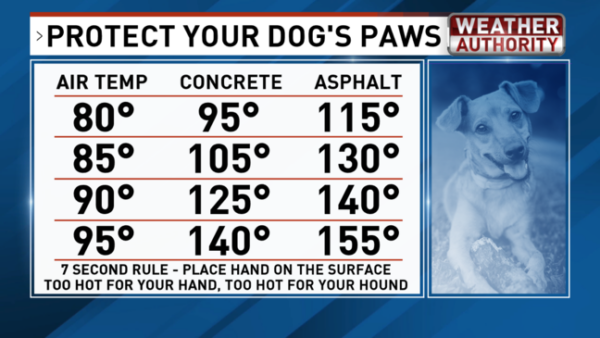Protecting Your Pet During Hot Summer Days: What to Know
As temperatures soar during the scorching summer months, it is crucial to take extra precautions to ensure the safety and well-being of our beloved pets. Dogs, cats, and other animals are susceptible to heat-related illnesses, and it is our responsibility as pet owners to protect them. As a result, we would like to provide essential tips on how to safeguard your furry and feathered friends during hot summer days. From understanding when it’s safe to walk your dog outdoors to recognizing signs of heat stroke and taking prompt action, we’ve got you covered.

Traveling with Pets
Whether you’re embarking on a road trip or flying to a vacation destination, these tips will help keep your pets safe and comfortable during travel:
- Never Leave Pets Unattended: Never leave your pets alone in a vehicle. Temperatures inside a car can quickly soar, leading to life-threatening heat stroke.
- Provide Adequate Ventilation: If traveling by car, ensure proper ventilation by opening windows slightly or using a pet-friendly travel crate with ventilation openings.
- Hydration and Breaks: Offer water to your pet regularly during the journey and take frequent breaks to allow them to stretch their legs and relieve themselves. [1][2]
Know When It’s Safe to Walk Your Dog Outdoors
Walking your dog is an excellent form of exercise and mental stimulation, but it is essential to consider the heat and humidity levels before heading out. High temperatures can be dangerous for your pet’s paws and overall well-being. To determine if it’s safe to walk your dog outside, keep the following guidelines in mind:
- Check the temperature: Avoid walking your dog during the hottest parts of the day, typically between 10 a.m. and 4 p.m. Instead, opt for early morning or late evening walks when temperatures are cooler.
- Assess the pavement: Place the back of your hand on the pavement for a few seconds. If it feels too hot to touch comfortably, it is too hot for your dog’s paws. Hot pavement can burn their paw pads, leading to pain and discomfort.
- Monitor humidity levels: Dogs regulate their body temperature through panting, and high humidity can hinder this process. If the humidity is high, consider shorter walks or engaging in indoor activities instead. [2][3]
 Recognize Signs of Heat Stroke
Recognize Signs of Heat Stroke
Heat stroke is a life-threatening condition that occurs when a pet’s body temperature rises rapidly and cannot be controlled. Certain breeds of animals are more vulnerable to heat stroke due to their physical characteristics, such as thick coats, short muzzles, or brachycephalic (flat-faced) features.
“Brachycephalic breeds are dogs with a flat, wide skull and a short nose. Like Boston terriers, Frenchie, Pekingese, Shi Tzus, Pugs, and Bulldogs. That adorable face has a lot crammed into a small space, and the crowding of the soft tissues, tongue, and cartilage restricts airflow, making it more difficult for them to cool themselves down because they can’t pant and breathe as efficiently,” says Olivia Hernandez, Veterinary Technology Program Director at Carrington College in Pleasant Hill.
It’s important to note that individual animals within any breed can react differently to heat, and other factors like age, overall health, especially pets with respiratory issues, and activity level also play a role in their vulnerability to heat stroke. Therefore, it’s crucial to take precautions to keep all pets safe during hot weather, regardless of their breed or physical characteristics.
Always provide access to shade, fresh water, and a cool environment, and avoid leaving pets in parked cars or exposed to direct sunlight for extended periods. If you suspect your pet is suffering from heat stroke (signs include excessive panting, drooling, weakness, vomiting, and collapse), seek immediate veterinary attention.
It is vital to be vigilant and identify the signs of heat stroke, including:
- Dogs:
- Excessive panting and drooling
- Rapid heartbeat
- Weakness and fatigue
- Vomiting or diarrhea
- Reddened gums and tongue
- Collapsing or seizures
- Cats:
- Panting (cats rarely pant, so it’s a sign of distress)
- Restlessness and pacing
- Excessive grooming or drooling
- Lethargy and weakness
- Elevated body temperature
- Birds:
- Fluffed feathers
- Open-mouthed breathing
- Rapid breathing
- Lethargy and sitting on the bottom of the cage
- Loss of coordination or difficulty flying
What to Do If Your Pet is Experiencing Heat Stroke
If you suspect your pet is suffering from heat stroke, take immediate action to cool them down and seek veterinary assistance. Follow these steps:
- Move your pet to a cool and shaded area.
- Apply cool water to their fur and skin, particularly on their head and neck. Do not use ice-cold water as it can constrict blood vessels and hinder heat dissipation.
- Use a fan or air conditioning to further aid in cooling your pet.
- Offer small amounts of cool (not cold) water to drink.
- Contact your veterinarian for further guidance and arrange for immediate medical attention.
Remember, heat stroke is a medical emergency, and professional veterinary care is essential to ensure your pet’s well-being. [4][5][6]
Beware of Water Intoxication
While it’s essential to keep pets hydrated, too much water can also pose a risk. Water intoxication, a condition that occurs when pets consume large amounts of water quickly, can lead to a dangerous electrolyte imbalance. It’s more common in dogs that love to play in the water, such as retrieving balls from the pool or lake.
“Many people think about keeping their pets cool and one way to do that is to let them swim. What they don’t know is that they can actually ingest too much water while playing and swimming that it dilutes their electrolytes, particularly sodium, and potassium,” says Amy Abel, Veterinary Technology Program Director at Carrington College in Stockton.
Protecting your pet from water intoxication involves being aware of the risks and taking precautions during water-related activities. Here are some tips to help prevent water intoxication in pets:
- Supervise Water Play: During play sessions involving water, encourage your pet to take breaks and rest to avoid continuous, excessive water consumption. If your pet enjoys playing in water, provide shallow water sources such as kiddie pools or shallow ponds, where they can easily access the surface.
- Avoid High-Risk Situations: Be cautious around large bodies of water as lakes, rivers, and oceans can pose a higher risk of water intoxication due to the potential for ingesting large amounts of water while playing fetch or retrieving objects. Also, ensure your pet always has access to fresh water, so they don’t feel compelled to drink excessively when presented with water during playtime.
- Recognize the Signs: Educate yourself about the symptoms of water intoxication, which may include vomiting, lethargy, loss of coordination, and bloating. If you notice any of these signs, seek immediate veterinary attention. [7] [8]
“The symptoms are ataxia, wobbling around like they are drunk, hence the name water intoxication, lethargy, nausea, vomiting, and even bradycardia (slower than normal heart rate). This is also a medical emergency and needs to be treated ASAP by a Veterinarian,” adds Amy.
Prioritize Your Pet’s Safety in the Heat
As responsible pet owners, it is our duty to protect our beloved animals from the dangers of hot summer days. By following the guidelines above, you can ensure your dog, cat, or bird stays safe and comfortable.
Remember, prevention is key. Always provide access to fresh water, ensure adequate shade, and never leave your pet unattended in a parked car, even for a short period. By being proactive and attentive, you can enjoy the summer season while keeping your furry and feathered companions happy, healthy, and safe.
Always consult with your veterinarian for personalized advice and recommendations based on your pet’s breed, age, and overall health. With proper care and attention, we can ensure that our furry and feathery friends stay safe, healthy, and happy throughout the summer months.
Please note that the information provided in this blog post is for general guidance and should not substitute professional veterinary advice. If you have specific concerns or questions about your pet’s health, consult with a qualified veterinarian.
Sources:
[1] American Kennel Club (AKC): “Tips For Keeping Your Dog Safe This Summer” – https://www.akc.org/expert-advice/health/summer-safety-tips-for-dogs/
[2] The Humane Society of the United States: “Keep Pets Safe in the Heatl” – https://www.humanesociety.org/resources/keep-pets-safe-heat
[3] PetMD: “10 Summer Dog Walking Tips” – https://www.petmd.com/dog/general-health/summer-dog-walking-tips
[4] AAHA: “How Can I Prevent Heatstroke in my Pet” – https://www.aaha.org/your-pet/pet-owner-education/ask-aaha/how-can-i-prevent-heatstroke-in-my-pet/
[5] American Kennel Club (AKC): “How Hot Is Too Hot? Heatstroke in Dogs” – https://www.akc.org/expert-advice/health/heatstroke-in-dogs/
[6] Wag! “Overheating in Birds” – https://wagwalking.com/bird/condition/overheating
[7] ASPCA Pro: “Treating Acute Water Intoxication in Pets” – https://www.aspcapro.org/resource/treating-acute-water-intoxication-pets
[8] American Kennel Club (AKC): “Can Dogs Drink Too Much Water? The Dangers of Water Intoxication” – https://www.akc.org/expert-advice/health/can-dogs-drink-much-water-dangers-water-intoxication/
[9] Protect Your Dogs Paws: https://wpde.com/weather/abc-15-weather-authority-blog/as-temps-ramp-up-protect-your-dogs-paws


